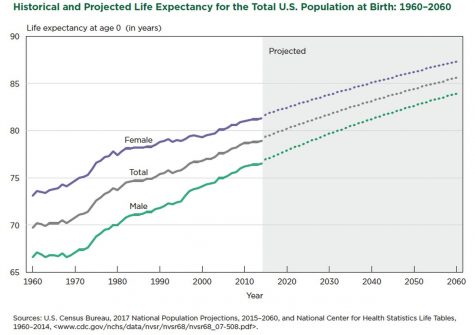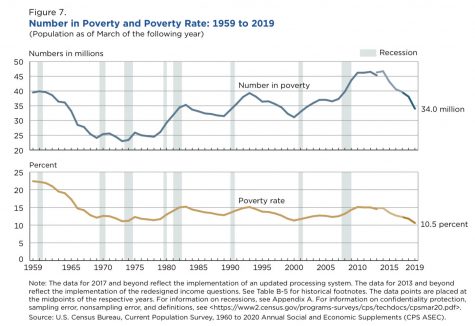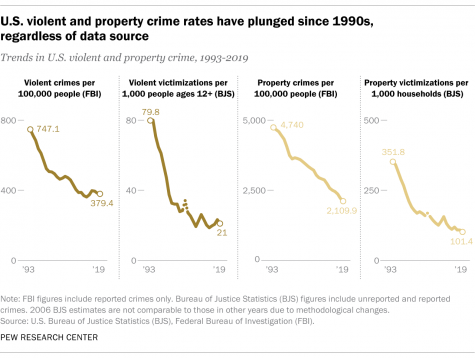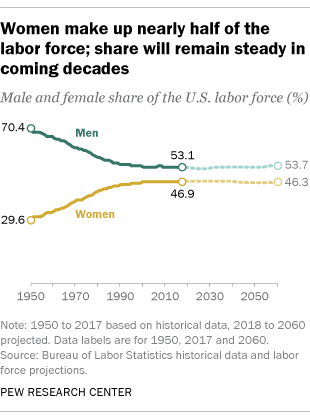Caleb’s Concepts: The U.S.’s best days are still ahead
March 5, 2021
New research tells us that COVID-19 has reduced the U.S. life expectancy by about a year, lowering the average life expectancy to about 77 and a half years. While there is an improvement, the unemployment rate is still above 6%, and U.S. children from third to eighth grade have suffered a drop in their math test scores. COVID-19 has made life difficult for everyone and some go so far as to label 2020 the worst year ever. But is the world today worse than it was 50 years ago?
Regardless of how bleak COVID-19 makes things appear, the world is far better than it has ever been. Below are five areas that the U.S. has made progress in despite COVID-19:
Life Expectancy
In the 1960s, the average life expectancy was just under 70 years. Despite living through a pandemic that has killed over hundreds of thousands of our fellow Americans, we still live, on average, 7.48 years longer than we did 50 years ago. Based on the U.S. Census projections, the average person in the U.S. should live past their 85th birthday by 2060. While COVID-19 has shortened our life expectancy by slightly over a year, this should not affect the long-term improvement in life expectancy. This is because we have access to better medical technologies and policies like the Affordable Care Act that give millions of previously uninsured Americans access to health care services.

IQ scores
Current generations are typically smarter than previous generations. IQ testing can help determine an individual’s different intelligence types. Tests are typically conducted on a sample of children and then standardized, with average intelligence falling around 100. Future generations are then given new tests, and their scores usually fall on the same pattern. However, intelligence researcher James Flynn asked “How does each subsequent generation place on the previous generation’s tests?” Flynn’s findings, known as the Flynn effect, demonstrate that each subsequent generation did significantly better than previous generations at the time of his study.
While recent events suggest that many people are still pretty dumb, the actual data tells a different story. From 1909 to 2006 the U.S. gained 32.6 IQ points, the highest of all the listed countries, which means that an average person in 2006 would have been in the 95% percentile in 1909.
Poverty
Data obtained from the U.S. Census shows us that in 1959, 39 million people lived in poverty, representing 23% of the population. Fast forward to 2019, and 34 million people live in poverty, or around 10.5% of the population. The effects of COVID-19 backtracked recent progress. However, this isn’t unusual. Poverty increased dramatically during the 2008 Great Recession, only for it to fall dramatically shortly after. The difference between COVID-19 and the Great Recession is that the 2020 recession was not derived from a functional issue within the economy. Rather, it was governors choosing to prioritize the lives of their constituents over continued economic growth. Like everything in life, there are trade-offs and poverty will probably continue to rise until COVID-19 is back under control.

Crime
If you watch Fox News, you would probably never guess that overall crime has fallen by a lot since 1993. According to Pew Research, the violent crime rate fell to 49%; Robbery declined by 68%. Murder fell by 47% and aggravated assault is fell by 43%. Additionally, property crime fell by 55%, especially in rates of burglary which declined by 69%, motor vehicle theft declined 64% and larceny went down 49%.

While there was a rise in homicides in 2020, it remains improbable that we will see a 180-degree turn and witness high crime rates like we had in the past.
Gender Equality
According to Pew Research, in 1950, women made up 29.6% of the workforce. Fast forward to 2018, and women composed 46.9% of the labor force. The pay gap has also closed from $6.94 in 1980 to $3.23 in 2018 and women now outnumber men in college degrees obtained.

While many strides have been made in closing the gap, COVID-19 has caused many women to lose employment. According to the Brookings Institute, many women were concentrated in low-income and face-to-face jobs, which have been disproportionately affected by COVID-19. This negative impact on female wages is not a functional problem with the economy. Rather, it is a temporary problem resulting from politicians choosing to prioritize people’s lives over people’s pockets. When COVID-19 is over, we should expect to see the long run trend pick back up again.
Conclusion
2020 was not the worst year ever like many people claimed. The U.S. is a much better place to live in now than it was 50 years ago. Donald Trump ran a campaign in 2016 stating that we should Make America Great Again. Yet, we were better in 2016 than we had been in previous generations. The U.S. is a safer, smarter, healthier, less poor and more equal place. The long run trends show that sparring a long-term cataclysmic event, we will rebound and continue toward a better future.











